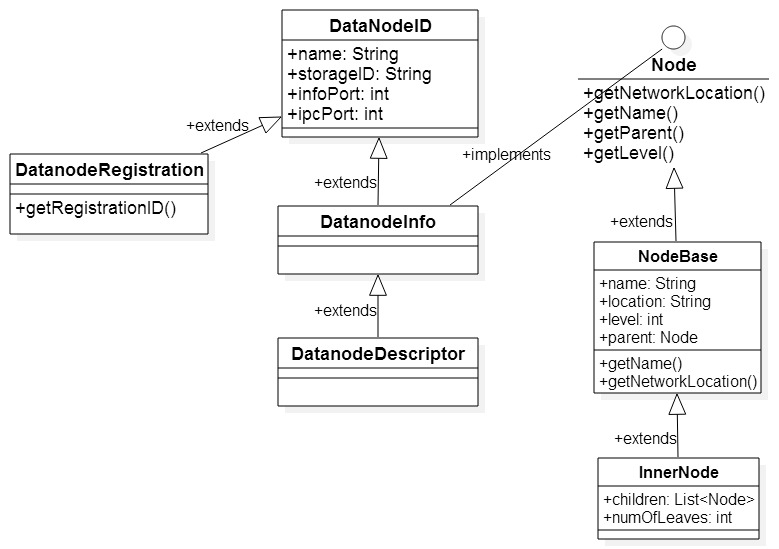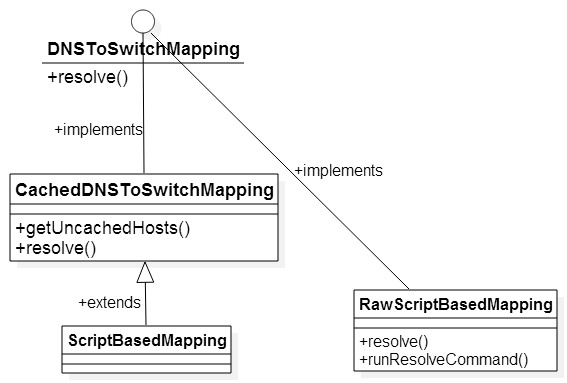hadoop机架感知与网络拓扑分析:NetworkTopology和DNSToSwitchMapping
hadoop网络拓扑结构在整个系统中具有很重要的作用,它会影响DataNode的启动(注册)、MapTask的分配等等。了解网络拓扑对了解整个hadoop的运行会有很大帮助。
首先通过下面两个图来了解与网络拓扑有关的类。

NetworkTopology用来表示hadoop集群的网络拓扑结构。hadoop将整个网络拓扑组织成树的结构(可以参考这篇文章https://issues.apache.org/jira/secure/attachment/12345251/Rack_aware_HDFS_proposal.pdf),其中Node接口代表树中的结点,既可以是树的内部结点(如data center,rack),也可以是叶子结点(就是host);而NodeBase实现了Node;NetworkTopology.InnerNode则代表树的内部结点。

DNSToSwitchMapping用来把集群中的node转换成对应的网络位置,比如将域名/IP地址转换成集群中对应的网络位置。CachedDNSToSwitchMapping则用来缓存已经被解析出来的映射。ScriptBasedMapping主要是解析用户配置的映射脚本,并根据脚本中的转换规则进行映射;这个脚本的位置由配置文件“core-site.xml”中的参数“topology.script.file.name”来指定。RawScriptBasedMapping是ScriptBasedMapping的内部类,脚本的执行由这个类中的resolve()方法完成。
下面以DataNode启动时向NameNode注册自己的结点为例,来说明映射过程。当DataNode启动的时候以DatanodeRegistration的形式,通过RPC调用NameNode的register()方法,向NameNode来注册本结点的信息,使得NameNode通过网络拓扑确定该DataNode在网络拓扑中的位置。其具体实现过程在FSNamesystem中的registerDatanode()方法中,具体代码如下:
/**
* Register Datanode.
* <p>
* The purpose of registration is to identify whether the new datanode
* serves a new data storage, and will report new data block copies,
* which the namenode was not aware of; or the datanode is a replacement
* node for the data storage that was previously served by a different
* or the same (in terms of host:port) datanode.
* The data storages are distinguished by their storageIDs. When a new
* data storage is reported the namenode issues a new unique storageID.
* <p>
* Finally, the namenode returns its namespaceID as the registrationID
* for the datanodes.
* namespaceID is a persistent attribute of the name space.
* The registrationID is checked every time the datanode is communicating
* with the namenode.
* Datanodes with inappropriate registrationID are rejected.
* If the namenode stops, and then restarts it can restore its
* namespaceID and will continue serving the datanodes that has previously
* registered with the namenode without restarting the whole cluster.
*
* @see org.apache.hadoop.hdfs.server.datanode.DataNode#register()
*/
public synchronized void registerDatanode(DatanodeRegistration nodeReg
) throws IOException {
String dnAddress = Server.getRemoteAddress();
if (dnAddress == null) {
// Mostly called inside an RPC.
// But if not, use address passed by the data-node.
dnAddress = nodeReg.getHost();
} // check if the datanode is allowed to be connect to the namenode
if (!verifyNodeRegistration(nodeReg, dnAddress)) {
throw new DisallowedDatanodeException(nodeReg);
} String hostName = nodeReg.getHost(); // update the datanode's name with ip:port
DatanodeID dnReg = new DatanodeID(dnAddress + ":" + nodeReg.getPort(),
nodeReg.getStorageID(),
nodeReg.getInfoPort(),
nodeReg.getIpcPort());
nodeReg.updateRegInfo(dnReg);
nodeReg.exportedKeys = getBlockKeys(); NameNode.stateChangeLog.info(
"BLOCK* registerDatanode: "
+ "node registration from " + nodeReg.getName()
+ " storage " + nodeReg.getStorageID()); //在datanodeMap与host2DataNodeMap查找该DataNode
//但如果该DataNode是第一次注册的话(而不是重启后的注册),nodeS与nodeN都为null
DatanodeDescriptor nodeS = datanodeMap.get(nodeReg.getStorageID());
DatanodeDescriptor nodeN = host2DataNodeMap.getDatanodeByName(nodeReg.getName()); if (nodeN != null && nodeN != nodeS) {
NameNode.LOG.info("BLOCK* registerDatanode: "
+ "node from name: " + nodeN.getName());
// nodeN previously served a different data storage,
// which is not served by anybody anymore.
removeDatanode(nodeN);
// physically remove node from datanodeMap
wipeDatanode(nodeN);
nodeN = null;
} if (nodeS != null) {
if (nodeN == nodeS) {
// The same datanode has been just restarted to serve the same data
// storage. We do not need to remove old data blocks, the delta will
// be calculated on the next block report from the datanode
NameNode.stateChangeLog.debug("BLOCK* registerDatanode: "
+ "node restarted");
} else {
// nodeS is found
/* The registering datanode is a replacement node for the existing
data storage, which from now on will be served by a new node.
If this message repeats, both nodes might have same storageID
by (insanely rare) random chance. User needs to restart one of the
nodes with its data cleared (or user can just remove the StorageID
value in "VERSION" file under the data directory of the datanode,
but this is might not work if VERSION file format has changed
*/
NameNode.stateChangeLog.info( "BLOCK* registerDatanode: "
+ "node " + nodeS.getName()
+ " is replaced by " + nodeReg.getName() +
" with the same storageID " +
nodeReg.getStorageID());
}
// update cluster map
clusterMap.remove(nodeS);
nodeS.updateRegInfo(nodeReg);
nodeS.setHostName(hostName); // resolve network location
resolveNetworkLocation(nodeS);
clusterMap.add(nodeS); // also treat the registration message as a heartbeat
synchronized(heartbeats) {
if( !heartbeats.contains(nodeS)) {
heartbeats.add(nodeS);
//update its timestamp
nodeS.updateHeartbeat(0L, 0L, 0L, 0);
nodeS.isAlive = true;
}
}
return;
} // this is a new datanode serving a new data storage
//正常启动的DataNode,其StorageID都不会为“”
if (nodeReg.getStorageID().equals("")) {
// this data storage has never been registered
// it is either empty or was created by pre-storageID version of DFS
nodeReg.storageID = newStorageID();
NameNode.stateChangeLog.debug(
"BLOCK* registerDatanode: "
+ "new storageID " + nodeReg.getStorageID() + " assigned");
}
// register new datanode
//NetworkTopology.DEFAULT_RACK实际上为/default-rack
//系统会将该DataNode的网络位置设置为默认的网络位置:/default-rack
//然后在后续的操作中,如果发现用户配置了映射脚本,则对该网络位置进行修正
DatanodeDescriptor nodeDescr
= new DatanodeDescriptor(nodeReg, NetworkTopology.DEFAULT_RACK, hostName);
//解析该node的网络位置
resolveNetworkLocation(nodeDescr);
unprotectedAddDatanode(nodeDescr);
//clusterMap就是NetworkTopology,将解析出来的node添加到网络拓扑中
clusterMap.add(nodeDescr); // also treat the registration message as a heartbeat
synchronized(heartbeats) {
heartbeats.add(nodeDescr);
nodeDescr.isAlive = true;
// no need to update its timestamp
// because its is done when the descriptor is created
} if (safeMode != null) {
safeMode.checkMode();
}
return;
}
其中,网络位置的解析在resolveNetworkLocation()方法中:
/* Resolve a node's network location */
//这个方法就开始解析某个DataNode的网络位置了
private void resolveNetworkLocation (DatanodeDescriptor node) {
List<String> names = new ArrayList<String>(1);
if (dnsToSwitchMapping instanceof CachedDNSToSwitchMapping) {
//通过getClass()方法知道,dnsToSwitchMapping是ScriptBasedMapping的实例
// get the node's IP address
names.add(node.getHost());
} else {
// get the node's host name
String hostName = node.getHostName();
int colon = hostName.indexOf(":");
hostName = (colon==-1)?hostName:hostName.substring(0,colon);
names.add(hostName);
} // resolve its network location
//因为ScriptBasedMapping继承了CachedDNSToSwitchMapping
//所以此处会调用CachedDNSToSwitchMapping的resolve()方法
//返回的是已经被解析出来的网络位置
List<String> rName = dnsToSwitchMapping.resolve(names);
String networkLocation;
if (rName == null) {
LOG.error("The resolve call returned null! Using " +
NetworkTopology.DEFAULT_RACK + " for host " + names);
networkLocation = NetworkTopology.DEFAULT_RACK;
} else {
networkLocation = rName.get(0);
}
//修正该node的网络位置
node.setNetworkLocation(networkLocation);
}
resolveNetworkLocation()方法又会调用CachedDNSToSwitchMapping的resolve()方法来解析网络位置:
public List<String> resolve(List<String> names) {
// normalize all input names to be in the form of IP addresses
names = NetUtils.normalizeHostNames(names);
List <String> result = new ArrayList<String>(names.size());
if (names.isEmpty()) {
return result;
}
//确认该IP地址是否已经被缓存
List<String> uncachedHosts = this.getUncachedHosts(names);
// Resolve the uncached hosts
//通过getClass()知道,rawMapping是RawScriptBasedMapping的实例
//如果用户指定了映射脚本,则根据脚本进行转换
//否则返回默认的网络位置:/default-rack
List<String> resolvedHosts = rawMapping.resolve(uncachedHosts);
//将未缓存的IP地址与其对应的网络位置进行缓存
this.cacheResolvedHosts(uncachedHosts, resolvedHosts);
//返回该IP地址对应的网络位置
return this.getCachedHosts(names);
}
而在CachedDNSToSwitchMapping的resolve()方法中,又会调用RawScriptBasedMapping的resolve()方法来完成网络位置解析。该方法主要是两方面功能:如果用户没有指定映射脚本,那么返回默认的网络位置:/default-rack;否则根据指定脚本中国的映射规则来进行转换。
//SCRIPT_FILENAME_KEY的值为"topology.script.file.name"
this.scriptName = conf.get(SCRIPT_FILENAME_KEY); public List<String> resolve(List<String> names) {
List <String> m = new ArrayList<String>(names.size()); if (names.isEmpty()) {
return m;
} //若没有指定脚本
if (scriptName == null) {
for (int i = 0; i < names.size(); i++) {
m.add(NetworkTopology.DEFAULT_RACK);
}
return m;
} //若指定了脚本,则运行脚本进行解析
String output = runResolveCommand(names);
if (output != null) {
StringTokenizer allSwitchInfo = new StringTokenizer(output);
while (allSwitchInfo.hasMoreTokens()) {
String switchInfo = allSwitchInfo.nextToken();
m.add(switchInfo);
} if (m.size() != names.size()) {
// invalid number of entries returned by the script
LOG.warn("Script " + scriptName + " returned "
+ Integer.toString(m.size()) + " values when "
+ Integer.toString(names.size()) + " were expected.");
return null;
}
} else {
// an error occurred. return null to signify this.
// (exn was already logged in runResolveCommand)
return null;
} return m;
}
至此,网络位置的解析工作结束。但有几点需要注意:
1、网络位置是该结点的父目录的位置,也就是说,如果集群中有一个结点node1,其在集群中所处的位置为:/d1/r1/node1,则其网络位置则为:/d1/r1,并不包含自身。
2、如果集群中没有配置映射脚本,那么默认所有的叶子结点都在同一个rack下,这个rack就是“/default-rack”,即所有叶子结点都在“/default-rack”下。
3、关于结点的Level。在Node接口中,定义了getLevel()方法,用来获取该node在网络拓扑树中的层级。其中,树的根的level为0,其孩子(也就是rack)为1,而叶子结点(就是host)为2。
但无论集群是否配置了映射脚本,所有rack的level都是1,所有叶子结点的level都是2。也就是说,在/default-rack/node结构与/d1/r1/node结构中,rack的level都是1,node的level都是2。
在本次学习源代码的过程中,更重要的是掌握了一种能够辅助阅读hadoop源代码的方法,那就是看测试类。根据测试类中的运行原理,来推测实际的运行情况,然后加以验证。事实上,这种方法有很大帮助。
本文基于hadoop1.2.1。如有错误,还请指正
参考文章:http://blog.csdn.net/shirdrn/article/details/4610578
http://caibinbupt.iteye.com/blog/298079
http://blog.csdn.net/azhao_dn/article/details/7091258
http://blog.csdn.net/xhh198781/article/details/7162270
http://blog.csdn.net/xhh198781/article/details/7106215
http://www.cnblogs.com/ggjucheng/archive/2013/01/03/2843015.html
https://issues.apache.org/jira/secure/attachment/12345251/Rack_aware_HDFS_proposal.pdf
转载请注明出处:http://www.cnblogs.com/gwgyk/p/4525463.html
附件下载地址: UML图
hadoop机架感知与网络拓扑分析:NetworkTopology和DNSToSwitchMapping的更多相关文章
- 【转载】Hadoop机架感知
转载自http://www.cnblogs.com/ggjucheng/archive/2013/01/03/2843015.html 背景 分布式的集群通常包含非常多的机器,由于受到机架槽位和交换机 ...
- hadoop机架感知
背景 分布式的集群通常包含非常多的机器,由于受到机架槽位和交换机网口的限制,通常大型的分布式集群都会跨好几个机架,由多个机架上的机器共同组成一个分布式集群.机架内的机器之间的网络速度通常都会高于跨机架 ...
- 第十三章 hadoop机架感知
背景 分布式的集群通常包含非常多的机器,由于受到机架槽位和交换机网口的限制,通常大型的分布式集群都会跨好几个机架,由多个机架上的机器共同组成一个分布式集群.机架内的机器之间的网络速度通常都会高于跨机架 ...
- hadoop之 hadoop 机架感知
1.背景 Hadoop在设计时考虑到数据的安全与高效,数据文件默认在HDFS上存放三份,存储策略为本地一份,同机架内其它某一节点上一份,不同机架的某一节点上一份.这样如果本地数据损坏,节点可以从同一机 ...
- 【Hadoop】Hadoop 机架感知配置、原理
Hadoop机架感知 1.背景 Hadoop在设计时考虑到数据的安全与高效,数据文件默认在HDFS上存放三份,存储策略为本地一份, 同机架内其它某一节点上一份,不同机架的某一节点上一份. 这样如果本地 ...
- 【原创】Hadoop机架感知对性能调优的理解
Hadoop作为大数据处理的典型平台,在海量数据处理过程中,其主要限制因素是节点之间的数据传输速率.因为集群的带宽有限,而有限的带宽资源却承担着大量的刚性带宽需求,例如Shuffle阶段的数据传输不可 ...
- Hadoop hadoop 机架感知配置
机架感知脚本 使用python3编写机架感知脚本,报存到topology.py,给予执行权限 import sys import os DEFAULT_RACK="/default-rack ...
- hadoop配置机架感知
接着上一篇来说.上篇说了hadoop网络拓扑的构成及其相应的网络位置转换方式,本篇主要讲通过两种方式来配置机架感知.一种是通过配置一个脚本来进行映射:另一种是通过实现DNSToSwitchMappin ...
- hadoop(三):hdfs 机架感知
client 向 Active NN 发送写请求时,NN为这些数据分配DN地址,HDFS文件块副本的放置对于系统整体的可靠性和性能有关键性影响.一个简单但非优化的副本放置策略是,把副本分别放在不同机架 ...
随机推荐
- css 水平垂直居中总结
空闲总结了下水平垂直居中方案,欢迎补充: 水平居中 水平居中有两种情况: 子元素是内联元素 这种那个情况下只需要在父元素定义: text-align:center; 例子: html: //省略了bo ...
- 简单介绍一下R中的几种统计分布及常用模型
统计学上分布有很多,在R中基本都有描述.因能力有限,我们就挑选几个常用的.比较重要的简单介绍一下每种分布的定义,公式,以及在R中的展示. 统计分布每一种分布有四个函数:d――density(密度函数) ...
- Spring+quartz整合问题
今天一开始在弄quartz的时候用的2.0.2的jar包整合Spring3.0.5的时候报错 Java.lang.IncompatibleClassChangeError: class org.spr ...
- 微信小程序-视图事件
事件 什么是事件 事件是视图层到逻辑层的通讯方式. 事件可以将用户的行为反馈到逻辑层进行处理. 事件可以绑定在组件上,当达到触发事件,就会执行逻辑层中对应的事件处理函数. 事件对象可以携带额外信息,如 ...
- 服务器上index.jsp变空
早上,前五分钟3台分别浏览了3台服务器,都是正常的,一会后台说其中一台打开页面是空白的,发现这台服务器上的index.jsp文件变成了空白.用其他服务器上的index.jsp文件覆盖,蹦出了另一个错误 ...
- PHP_EOL
PHP中除去换行符 $str = str_replace(array("\r\n", "\r", "\n"), "", ...
- 个人博客作业Week3
一.调研 下载并使用,按照描述的bug定义,找出几个功能性的比较严重的bug.至少两个.用专业的语言描述(每个bug 不少于 40字),如有必要,可以配图. 电脑用户未登录就能使用单词本功能,万一是用 ...
- HTTP协议的报文结构
HTTP 有两类报文: (1) 请求报文----从客户向服务器发送请求报文,见图6-12(a). (2) 响应报文----从服务器到客户的回答,见图6-12(b). 由于 HTTP是面向文本的(tex ...
- Jquery中$.get(),$.post(),$.ajax(),$.getJSON()的用法总结
本文对Jquery中$.get(),$.post(),$.ajax(),$.getJSON()的用法进行了详细的总结,需要的朋友可以参考下,希望对大家有所帮助. 详细解读Jquery各Ajax函数: ...
- OpenCV 计算区域的内部参数
对于一个区域,怎么进一步针对区域内部特征进行处理呢 ? 首先,我们要提取出来内部的某些特征才能说话,下面提取一些简单的特征,话不多说见代码: 1.平均数及方差参数: Mat tempMean, tem ...
